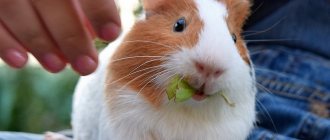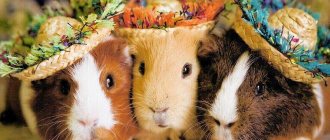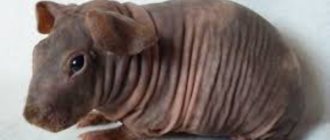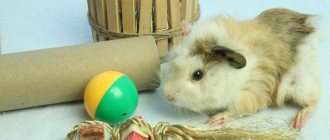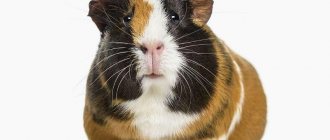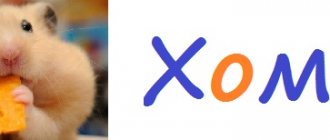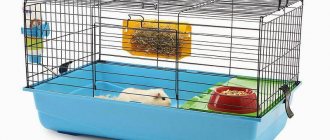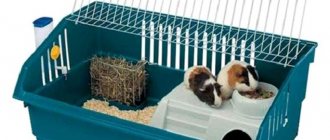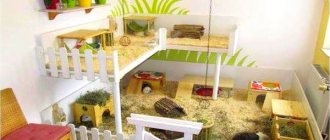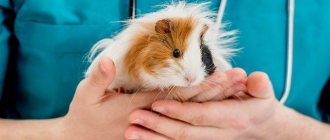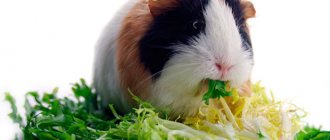Guinea pigs have long been popular pets. These cute rodents are easy to purchase in pet stores or at the Bird Market. However, the animals sold there are often outbred (crossbred) because they do not have any documents confirming their origin. Of course, this will not prevent the pig from becoming a pet, but if you plan to engage in serious breeding of these animals, then such a “breeding breeder” can please you with an unpredictably diverse offspring. For breeding, you should purchase purebred pigs of known origin. Today there are a number of clubs for guinea pig lovers that coordinate the activities of breeders and organize exhibitions. In these clubs you can purchase young animals of different breeds with pedigrees. The choice of breeds is quite large: from the already familiar smooth shorthaired, Peruvian and Abyssinian, to a variety of rare and exotic ones (curly Texels, crested Cresteds, etc.). In general, today there are more than 80 breeds of guinea pigs, differing in the structure, length and color of their coat, and thanks to the work of breeders, more and more new ones are appearing. The most popular marine breeds will be discussed in this article.
There are various classifications of guinea pig breeds in the literature. One of the most common classifications is the division of guinea pigs into three large groups - long-haired, short-haired and rare. Modern breeders also use the following option for dividing into groups:
- English Self - guinea pigs of solid color (solid color)
- Long Hair non Selfs - (Sheltie, Peruvian, Coronet, Texel, Alpaca, Merino)
- Short-haired (woolen) (Coated, non Selfs) - (agouti, American and English Cresteds, Abyssinians, Rexes, etc.).
- Rare Varieties are so-called new breeds that are still quite rare.
The range of colors in guinea pigs is also very diverse; they can be completely monochromatic (white, black, buff, red, chocolate), agoute (natural color), variegated, two or three colors, and even Dalmatians.
Selfies
Selfies are one of the ancient representatives of the pig family. They were developed in Great Britain in the 19th century. A distinctive feature of Selfies is their uniform (solid) coat color (white, black, brown, beige, lilac, etc.). The eyes are often dark, but can also be red. The photo shows a guinea pig of the English Self breed.
One interesting feature of this breed has been noticed: females living together in the same cage or enclosure take care of the offspring through joint efforts; we can say that these are the only family rodents of their kind.
Diet
“What do guinea pigs eat?” – this question is quite common, especially when a person decides to get such a pet. Rodents are not quite picky when choosing food. Thanks to this property, they easily settle into a new place. The pet's diet includes grain, fresh grass, hay, dairy products, vegetables and fruits. Some herbs may be poisonous, so you should give approved herbs:
- clover;
- dandelion, or rather its leaves;
- nettle;
- plantain.
Abyssinian (rosette) guinea pigs
The Abyssinian breed is one of the most popular. Abyssinians first appeared in England in 1861 as a result of a mutation in the coat gene, and in 1866 the first individuals were brought to Europe.
A characteristic feature of the Abyssinian breed is a special growth of hair, which is why rosettes are formed (the hair in the rosettes diverges from the center to the periphery). Rosettes must be of the correct shape and have clear boundaries. The total number of sockets is 8-10, maximum 12. The standard specifies their location: 2 on the nose, 1-2 on the shoulders, 4 on the sides and 4 on the back of the body. In addition, they must be symmetrical. In some individuals, as a result of mutation, the number of rosettes can reach 30 pieces - these are no longer considered purebred. The rosettes located nearby form tufts, or ridges. Any colors are possible. The fur reaches 3-4 cm in length; in females it is softer than in males. The body of Abyssinian pigs is strong, muscular, and moderately long. The shoulders and chest are wide, the back is straight, the back is rounded. The legs are straight and short. The head is short, rounded, with large ears, large shiny eyes and a slightly elongated nose (this is called a Roman nose).
How to find out the breed
When purchasing an animal at a pet store or online, you need to know how to determine the breed of guinea pig. This is necessary so as not to buy the most ordinary animal under the guise of a rare cavy with an unusual color. You can learn about the breeds on numerous sites and forums of pig breeders, where detailed descriptions of the animals with photographs are given. You can also contact clubs for explanations of the characteristics of a particular Kavy breed.
Skinny guinea pig breed
Baldwin breed of hairless pigs
Breeders are willing to share information. However, some breeds of animals are recognizable: Teddy has plush fur and looks more like a toy, Skinny has no hair at all, and Alpacas have funny curls. Which breed is best to choose in the end depends on capabilities and personal preferences.
Peruvian guinea pigs
This is a fairly old breed, known in Europe since the mid-19th century. In Peruvian pigs, the hair grows forward, towards the muzzle from two rosettes located on the rump, and falls over the eyes. Ideally there should be only 2 sockets at the bottom. The length of the coat must be at least 15 cm, and for show-class Peruvians it can reach 50 cm.
Alpaca
Alpacas are very similar to Peruvian guinea pigs, but have a more wavy coat that also grows forward towards the face. There are two sockets at the back.
Sheltie
In England, Shelties were recognized in 1973, in the USA - in 1980.
The long coat, which grows strictly from the muzzle downwards, is soft and silky. Unlike alpacas, Abyssinian and Peruvian guinea pigs, there is not a single rosette on the body. There are different colors.
Coronets
The same shelties, but on the crown there is a rosette that looks like a crown.
Breed classification
Officially, all breeds of guinea pigs are divided into:
- Longhaired,
- Short-haired.
Rosette breed of guinea pigs
However, the types of guinea pigs also have an unofficial classification:
- Rare,
- Popular.
Not only the length and structure of the coat depends on the breed of the animal.
Texels
Texel is one of the most beautiful breeds, known since the mid-80s of the last century. Texels are distinguished by long, thick fur that breaks up into clearly defined curls, a long train and fluffy sideburns. The length of the coat is 12-18 cm. The rounded muzzle is decorated with large expressive eyes. Texels are calm, friendly and sociable.
Looking at the photo of a Texel guinea pig, it seems that caring for such luxurious fur requires special effort. In reality, they do not require daily brushing, and it does not take much time to select hay and sawdust from their fur. Animals that do not take part in exhibitions usually have their fur shortened.
Merino
The curly coat grows in the same way as the Texel, only there is a rosette on the head.
Agouti
Agoutis are the ancestors of all modern breeds. Each animal's hair has different shades at the base and at the end.
Roans
The head, paws, ears are painted in the main color without any admixture of another shade, only on the body there is a so-called salt and pepper mixture, when hairs of one color are mixed with hairs of another color.
Teddy
Teddies are similar to Rex cats, but their fur is slightly shorter and softer. Thick, dense and elastic, straight (or slightly wavy), the hair stands on end all over the pig's body, and feels like plush. Pictured is a Gold and White American Teddy
Rex
The main difference between Rex guinea pigs is their hard, dense, slightly curly fur, about 1.7 cm long. The hairs stand on end, which creates a plush effect. Color options can be any.
Ridgeback
It is a smooth-haired pig, but there is a difference - there is a rosette on the rump, and on the back the hair is collected into a kind of comb of standing vertical hair.
Cresteds
Smooth-haired pigs with a rosette on the crown. There are English and American Cresteds. In American cats, the color of the rosette should contrast with the color of the main color; in English cats, it should be identical to it.
Satin guinea pigs
A distinctive feature of the satin pig group is its surprisingly soft, silky coat with a glossy effect. The wool shines and shimmers due to the special hollow structure of the hairs. The Satin coat type is found in all short-haired and long-haired breeds. The rarest animals are golden, lilac and buffalo in color.
Description
Guinea pigs come from the family of semi-ungulate rodents. They have the appropriate appearance and body structure.
- The body shape of rodents resembles a small cylinder. It can reach 22 centimeters in length. Sometimes there are representatives of larger sizes.
- The spine of pigs has a complex structure and consists of cervical, lumbar, sacral, thoracic and caudal vertebrae.
- The collarbone of these animals is completely absent, and the same applies to the tail.
- Boys are much larger than the female half of animals. An adult guinea pig weighs on average 1.2 kilograms.
- The limbs of guinea pigs are small. The hind legs are longer than the front ones.
- Animals have three toes on their hind legs, and four on their front legs. They look like small hooves.
- In a week, an animal's fur can grow half a centimeter.
- The shape of the head is very large. Has a high degree of brain activity.
- Animals' teeth grow continuously throughout their lives. In a week, incisors can grow by 1.5 millimeters. These mammals have very powerful teeth, so the animals can easily gnaw roots and plant stems.
- The digestion process takes a fairly long period of time. This is explained by the large length of the organ.
- Guinea pigs can be found with either long or short fur. The color of the cover is not limited to one color and can be varied.
- In the wild, the maximum age of animals does not exceed seven years. At home, it is determined by the proper care and maintenance of the pet. The lifespan of a domesticated rodent can reach fifteen years.
Skinny
These pigs of truly exotic appearance appeared as a result of a mutation in 1978 at the Institute of Montreal (Canada). They have no fur, only on the nose and paws there are sparse curly and coarse hairs. Skinny skin is very soft and velvety. The most common color is chocolate; there are black, tortoiseshell, silver, lilac, etc.
Skinnies have an excellent appetite, which is not surprising: they have a faster metabolism, as they need to retain body heat. Therefore, they eat 3 times more than their furry counterparts, sometimes gnawing on something all day long.
Due to their lack of fur, skinnies require a little more care and attention than regular guinea pigs. The main thing that future owners of these cute and gentle creatures need to know is that skinnies need to be protected from drafts and always kept warm. If fasting days are only beneficial for most animals, then for skinnies to remain for two days without food is literally like death. At the same time, skinnies are prone to obesity, so the owner’s task is to carefully consider the diet, establish a diet and strictly adhere to it.
Baldwins
Unlike Skinnies, who have tufts of hair on their paws and nose, Baldwins are a completely hairless breed. Babies are born covered with fur, like ordinary pigs, but by the age of one month it completely falls out. Baldwins have extremely delicate skin; both cold and direct sunlight are dangerous for it.
A person who has decided to get a guinea pig and has become acquainted with all the variety of breeds faces a difficult question: how to choose “your breed” among all this diversity?
Surely, many people want to have a rare breed of pig at home. Thus, hairless guinea pigs are very in demand and popular today. But here you need to take into account that these are more delicate and sensitive animals, they are more demanding in terms of care and living conditions. And the price for such exotics will be significantly higher than for pigs of less rare breeds. In addition, when purchasing a pig of a rare breed with a good pedigree, additional responsibility is imposed on the owner: you need to join a club, take part in exhibitions, find your pet the most suitable partner for mating, etc.
Pigs of less rare breeds can be no less beautiful and affectionate pets. Short-haired guinea pigs are easier to care for, they have high immunity, which means they get sick much less often than other breeds of pigs. Animals with short hair are the best choice for a novice breeder. In addition, if you are purchasing a guinea pig for a child, it is best to choose just such a pet. Caring for rosette pigs is also not very difficult, but they are somewhat more expensive. As for guinea pigs of long-haired breeds, they need more thorough coat care, which will require much more time.
- Guinea pig and...
- Why sea...
- Toys for…
- Guinea pig care
- How to choose and...
- Where and when is best...
Lifestyle and its duration
The lifespan of a guinea pig depends on many factors:
- Lifestyle;
- accommodations;
- food quality;
- diet;
- care and compliance with maintenance rules;
- heredity.
Domestic guinea pigs live longer than those that survive in natural conditions. To the question “How long do guinea pigs live?” It is quite problematic to answer, since this is individual for each rodent; in general, under favorable conditions, a pig can live about ten years. Since the pig belongs to the family of rodents, the teeth play the main role; the time frame for a full meal depends on how healthy the guinea pig’s teeth are. A healthy pet should have twenty teeth: lower and upper incisors, upper and lower premolars and molars. Molars differ from all others in their appearance, the root is an open type, which is in a growing state throughout the pet’s life. The teeth of pigs are always in motion, due to this the length of the constantly growing teeth is controlled. The upper jaw should protrude a couple of millimeters above the lower jaw. All teeth shrink at the same time and also grow back.
Ridgeback
Ridgebacks were bred in Sweden in 2004. Their most important external feature is a woolen comb running along the entire length of the back. The color of the hair is varied: from creamy white to ash black. Caring for your pet is incredibly simple: periodically comb out split hairs, introduce vitamin-mineral complexes into the diet during the spring molting period, and visit a veterinarian annually for a routine examination. Ridgebacks are very loyal and sensitive creatures. They do not like to be left alone for a long time, they adore the company of people, and are friendly towards other pets.
Ridgeback
Buying a hairless pet
Breeding and mating guinea pigs at home
The cost of a rodent is determined by its age, originality of color, and physical condition. Cubs can be sold when they are 3 weeks old. Bald pigs do not live long compared to their woolly counterparts, from 5 to 8 years. The low life expectancy of the animal is due to the sensitivity of the body and the tendency to colds.
A naked guinea pig is not cheap. A piglet with an original color can be purchased at a nursery for $100–$140. Through a private advertisement, you can buy a pig at half the price, but no one can vouch for the health of this animal. Typically, a hairless rodent is bought for a family where an adult or child is allergic to wool.
Why do hamsters fight?
Discussion: there is 1 comment
- vetpPaype:
10/29/2018 at 10:04 pmAs Antoine de Saint-Exupéry bequeathed, we are responsible for those we have tamed. All our pets provide loyalty, relaxation and joy from communication, but at the same time they represent a great responsibility. Pets require equal attention and good care. Therefore, absolutely any attentive owner always knows where, if necessary, he can buy veterinary drugs for his pet today. Veterinary drugs are not only medicines for diseases, to which, unfortunately, all representatives of the animal world are susceptible. Your beloved pet needs constant care, and above all, the prevention of various diseases. You will need anti-parasite medications, vitamin complexes, eye and ear drops, and vaccinations.
Answer
Baldwin
Baldwin pigs do not have hair. Their skin has a uniform light beige tint, and in some places it is covered with tiny folds. When purchasing such an animal, keep in mind that its skin is more susceptible to injury and inflammation. Periodically inspect your pet for any abrasions or scratches. If you are going to walk your Baldwin on the street, then choose a place for walking with special care: avoid polluted and dusty areas. These rodents are quite smart, cunning and friendly. When potential danger threatens, they deftly hide in a house or shelter.
Baldwin
Guinea pigs are amazing creatures that are popular among pet lovers. Most of them have a soft, calm, flexible character. Aggression occurs extremely rarely or is completely absent. The average life expectancy is 8-10 years. Provide your pet with quality care, and then he will delight you for many years.
Crested
Large rodents with short, smooth hair, on the frontal part of which there is a neat miniature crest - this is the Crested breed. Their color can be varied: from fiery red to coal black. They are unpretentious in care and nutrition, lead an active lifestyle mainly at night, and are incredibly sociable and trusting. In the summer, be sure to walk your pet on fresh lawn grass (use a special harness). Crested pigs may have certain problems with their teeth, so a mandatory condition for keeping them is the presence of a mineral stone in the cage.
Crested
